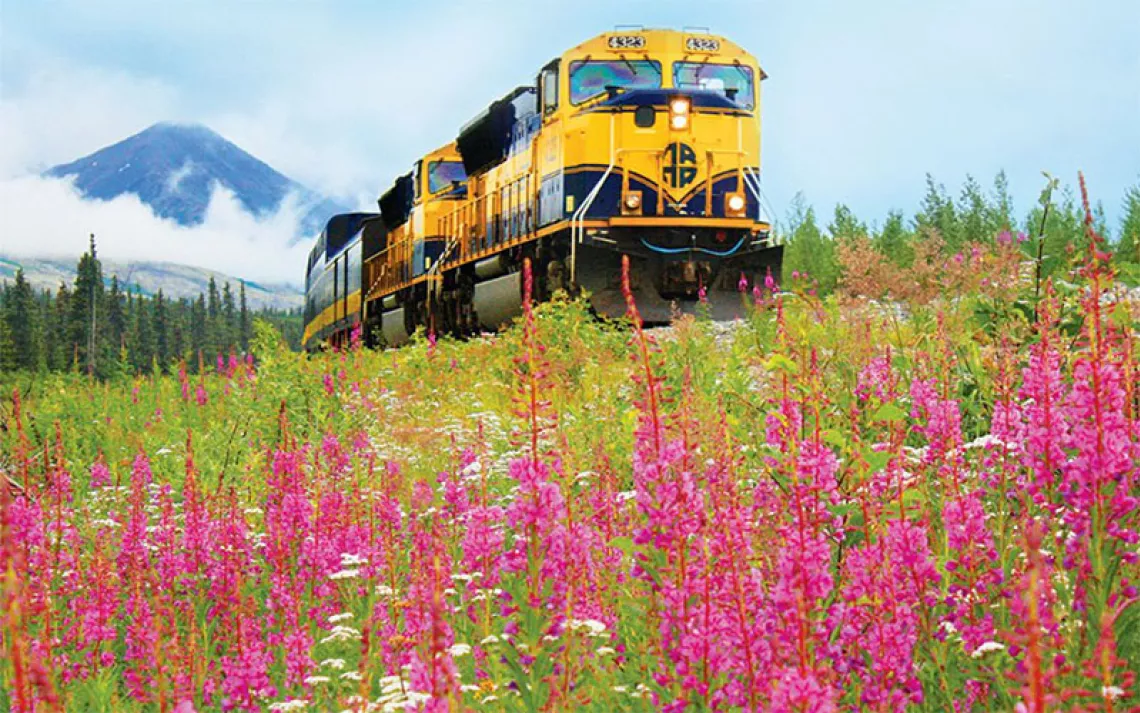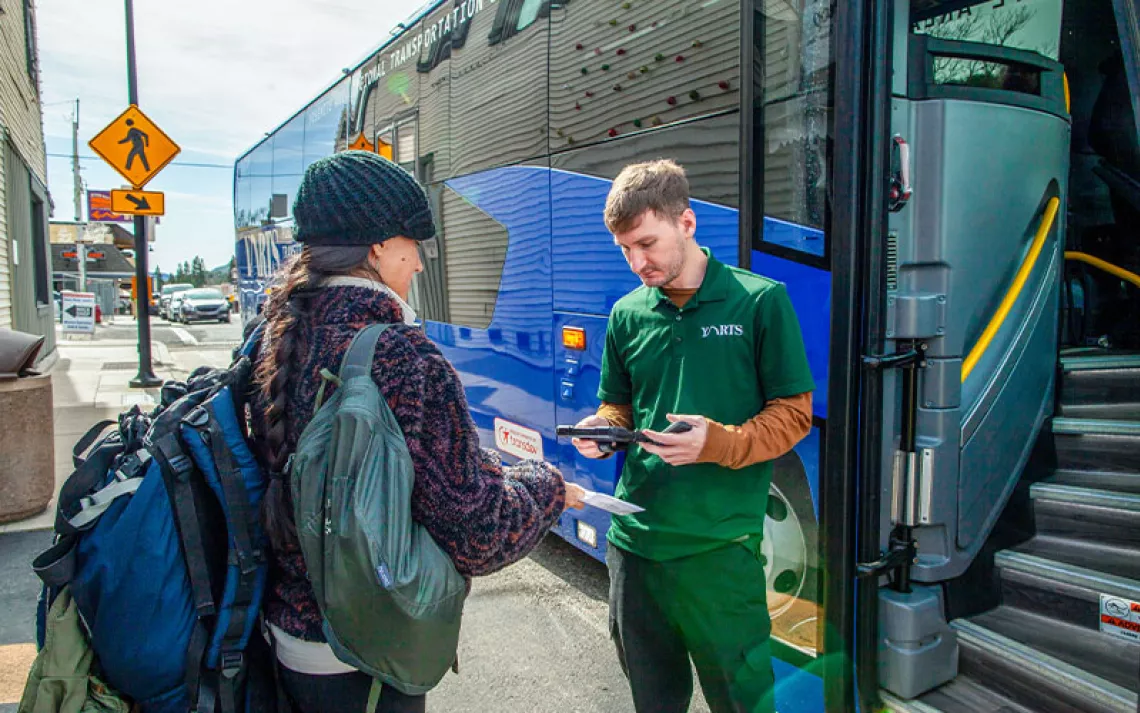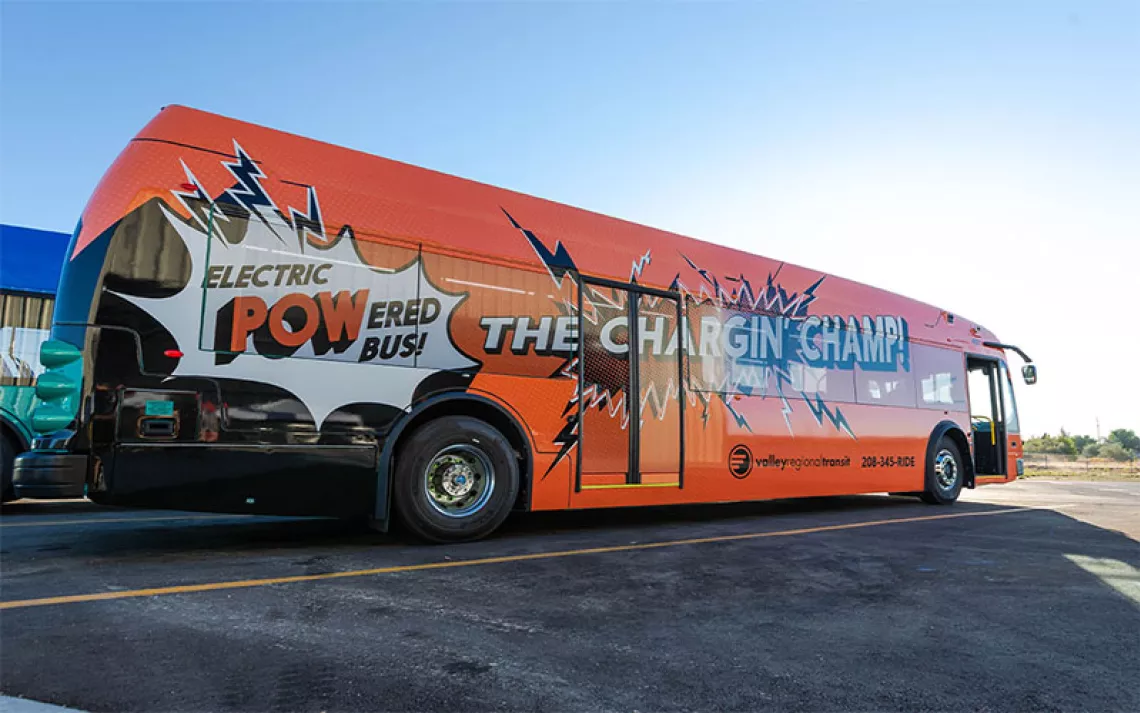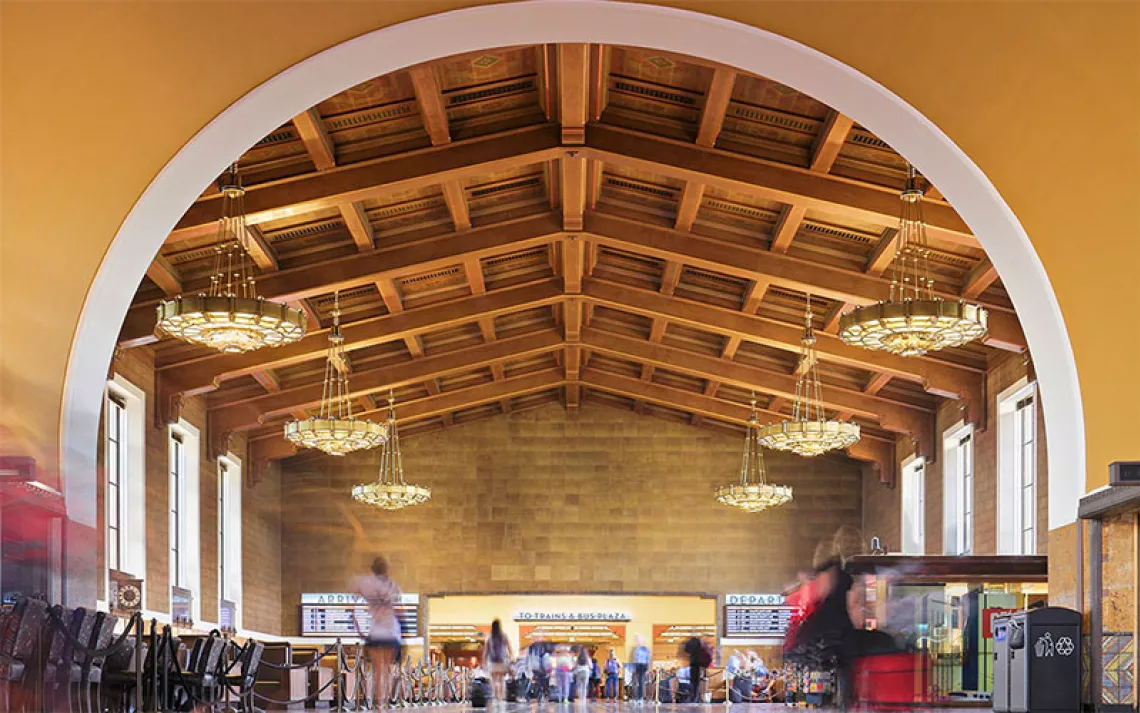Trains, Planes, & Pains: Amtrak’s High-Speed Rail Takes on the Airlines
What’s the best way to get from Point A to Point B? It could be a train
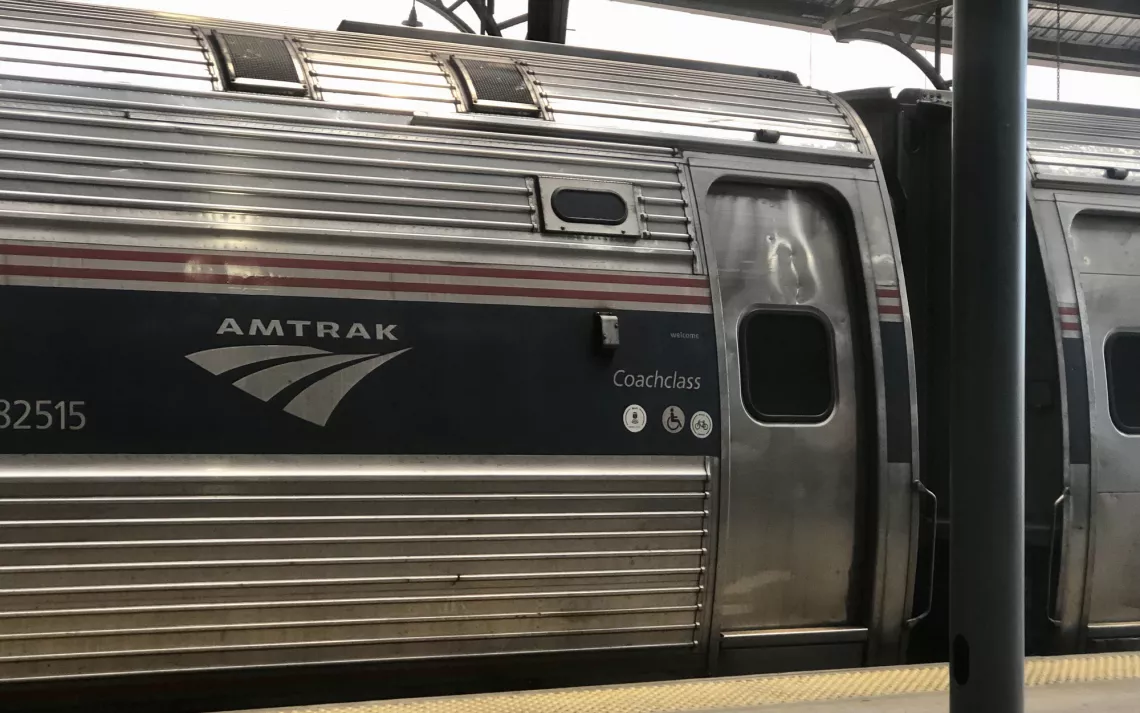
Contrails slash dawn’s rosy light high above Manhattan. Headlights stream down the West Side Highway, and the morning’s first ferry churns across the Hudson. I’m up early, rushing to a lunch meeting 215 miles away in Boston. I’ll catch Amtrak’s new high-speed train to Massachusetts, then fly home on the Delta shuttle. My schizophrenic itinerary has a purpose: I want to compare the two modes of travel head-to-head, assessing comfort, practicality, and cost—both to my bank account and to society, in environmental impacts.
Not many travelers—especially those on business trips—consider environmental effects when crafting their itineraries. Yet the societal benefits gained by putting green issues on the short list with legroom, arrival time, and quality of onboard peanuts could add up quickly: The kind of short hop I’m taking makes up 20 percent of all miles traveled.
In the 1970s, diesel trains sputtered between New York City and my North Carolina hometown. Leaning perilously on decaying tracks, they crept south past cotton fields and tobacco barns. Once, the engine hit a cow and later caught fire, extending an 8-hour trip to a 14-hour overnight. A few years later, a grueling 5-hour ride to Boston was ruining a budding long-distance romance. I gave up and hailed cabs to LaGuardia instead.
But recently I shot 345 miles overland from Osaka to central Tokyo in just 2.5 hours. Now it’s time to give Amtrak’s latest, fastest train a fair test. At 8:30, I leave Times Square. I could take a taxi, or one of seven subway lines to centrally located Penn Station. Instead, I hoof the eight blocks past shuttered theaters, claiming my $119 Internet-booked ticket from Amtrak’s machine ten minutes later. Waiting to board the 9:03, I settle into a sleek Acela Express lounge. For the first time ever in Penn Station, I relax my grip on my purse; only ticketed Acela passengers are admitted to its Plexiglas-enclosed waiting area.
The room is crowded, a reflection of the fact that Amtrak’s share of the Boston–New York market has jumped from 17 to 33 percent since 1997. I eavesdrop. Some riders are spooked by post–September 11 air travel. One man waves a Wall Street Journal article about how layoffs of mechanics may threaten aircraft maintenance. (Autos aren’t so safe either—highway deaths accounted for 94 percent of transportation fatalities in 2001, according to the National Transportation Safety Board.) And how ’bout the weather? When blizzards lashed the Northeast last winter, Amtrak was the only thing moving. Between New York and Boston, 90 percent of scheduled trains soldiered on, carrying stranded motorists and fliers.
Passenger rail once thrived in America. The introduction of steam locomotives in the early 1800s inspired long-distance travel and settlement of the western United States. But in the 1930s, automobiles began honking their siren call. Railways running passenger rail were decimated by the Depression. By the 1950s, affordable sedans sailed down Eisenhower’s new interstate highways. Finally, the rail lines unloaded their unprofitable human cargo when Congress created Amtrak in 1970 in an effort to save passenger rail service from the cost-cutter’s scrap heap. Still, passenger rail has teetered near extinction as Americans continue to opt for jets or cars and funding for Amtrak remains insufficient to produce a viable system.
But car culture has soured. By 2000, congestion cost urbanites some $68 billion annually, according to a Texas Transportation Institute study of 75 urban areas. Even in rural areas, the amount of time drivers spend stalled in traffic has quadrupled in the last two decades. Trains offer an alternative to gridlock, and rail may see a resurgence yet.
Once our train is announced, some 120 riders—less than half the Acela’s capacity—board quickly, funneling down a modernistic escalator sheathed in stainless steel. There’s no security check, and we’re rolling before anyone stows a bag. I settle into a comfortable seat and look around. More starship Enterprise than Orient Express, the Acela’s slate-blue decor features sliding doors, substantial footrests, and outlets for laptop computers. Some 15 minutes later, we’re chugging through Queens, still far below the Acela’s top speed. But it gets harder to read the lettering on roadside signs as we begin to outpace cars on the Bronx River Parkway.
In the cafe car, a businessman carries three steaming coffees to his conference table. I lean away, anticipating latte in my lap. But he walks smoothly, without lurching sideways. "It’s the tilting technology," says a Pennsylvania TV executive who rides the Acela weekly for work. Because existing track is so curvy, Acela trains compensate by leaning 4.2 degrees around the bends. If the Acela ran on dedicated track with wider spacing, concrete foundations, and broad curves, we could travel 150 miles per hour and reach Boston in under two hours. But this 100-year-old infrastructure—much owned and maintained by commuter rail lines—won’t support Acela technology for most of the ride. We slow to 20 mph where a spaghetti of tracks converges in New Rochelle. Later, I get a glimpse of the future when the Acela blurs to 150 mph along an 18-mile stretch of cutting-edge track north of Providence.
These aren’t cheap thrills. It took $3.8 billion to electrify and modernize much of the Northeast corridor’s infrastructure. In addition, an $850 million loan for Acela trains contributes mightily to Amtrak’s $3.9 billion debt. Lacking the billions needed to make systems truly efficient, most American high-speed rail projects idle in the study stage. Amtrak is passing on 200-mph bullet trains for now; instead, it’s aiming for "higher-speed" rail, increasing some existing service to 110 to 125 mph.
In Europe and Japan, commuters zoom between city centers on efficient high-speed trains. While on board, passengers work uninterrupted, or they walk around, enjoy meals, relax, snooze, or watch the scenery from spacious seats. In these countries, where governments provide substantial financial support, superfast rail has evolved into real competition for air travel.
In the American West, Amtrak’s Cascades is combining state, federal, and private funding while gradually approaching high-speed rail. It snakes from Vancouver, British Columbia, to Eugene, Oregon, along the way serving Seattle-Portland commuters. Instead of spending billions on a new 200-mph rail line, the Cascades uses existing freight tracks at 79 mph—the maximum allowed on routes without an automatic train-stop system. As grade crossings and track are improved, the Cascades will gain on its 110-mph target. But environmental gains may be immediate: Talgo, the Cascades’ Spanish manufacturer, says a 500 percent ridership increase over eight years has eliminated 1,340 tons of emissions annually.
Overall, trains produce a fraction of the carbon dioxide per passenger-mile of cars or planes. Humming by marshes and the New England coastline, I see egrets, boats, and trees—but no exhaust. The energy for Amtrak’s electric trains is generated by hydroelectric, coal, nuclear, and other means. While rail power isn’t pollution-free, its emissions can be controlled at the source more efficiently than the emissions of, say, millions of individual vehicles.
The Acela slides quietly into Boston’s renovated South Station on time at 12:33. I step onto the platform with two Brits who rode the fastest segment, from Providence to Boston. "It’s a smart train," exclaims the husband. "Like the Eurostar from London to Brussels." But there’s room for improvement. In the same 3.5 hours I was onboard, I could’ve gone nearly three times farther on France’s TGV. Its 621-mile North Sea–Mediterranean route operates at a consistent 186 mph.
Levitating trains are the next big thing, with Japanese prototypes setting a record 343 mph in 1999. Like a couple of extremely expensive refrigerator magnets, the magnetic levitation ("maglev") train and guideway repel each other without touching, propelling the vehicle to an average speed of 240 mph. A Baltimore-Washington maglev is being studied; if extended to New York, the commute to Washington could take just 90 minutes.
The final segment of my rail trip involves hopping on Boston’s Red Line train right from South Station. I make my Back Bay lunch date at 12:47, 4 hours and 17 minutes after leaving Times Square, with plenty of time to enjoy a grilled-salmon salad.
Given the hours I’ve invested, I might have lingered in Beantown. But time is money, and I’ve got a plane to catch. Since Eastern Airlines started flying shuttles in 1961, quickie flights have been the gold standard of executive travel. When airline deregulation added competition in 1978, pleasure trippers snapped up cheap short-haul fares, too. On the face of it, these swift flights seem to trump the trains. But the real race is measured in door-to-door travel time. Even with its track limitations, the Acela’s 3.5-hour New York–Boston run is closing in on the air shuttles; researchers already say high-speed rail can edge out flights for trips under 500 miles and 3 hours.
My return journey begins with an inauspicious snag. There’s no Red Line to Logan Airport, so I hail a cab on Newbury Street at 4:30, paying my $19 fare at Logan 25 minutes later. A machine prints my ticket in under a minute, but guards take their time inspecting my steel-tipped cowboy boots. Even with thorough security, Delta’s 5:30 flight boards quickly at 5:08, and we’re in the air at 5:48.
Crunched into seat 12C, I study my Delta receipt. The fare cost $202.79. But $23.71 in taxes bring the total to $226.50, nearly double the Acela’s price. Taxes? Amtrak didn’t tax me. But airlines levy security, facility, excise, federal ticket fees, and jet-fuel taxes to support the Aviation Trust Fund, which pays for airport costs, security, and air traffic control. Likewise, the Highway Trust Fund finances road improvements through gas and trucking-industry taxes. In all, aviation received $15.9 billion (including bailouts) from the feds in 2003; highways got $31.6 billion. Lacking a dedicated trust fund, Amtrak—which nearly shut down in July 2002—limped away with just over $1 billion. Largely left to sink or swim in the Northeast, Amtrak maintains its own infrastructure, police force, and dispatching system—often relying on local resources to maintain stations.
Trains may be strapped for cash, but Logan’s empty terminals reminded me of how troubled airlines have become, too, despite funding transfusions. Even after receiving their $15 billion, post–September 11 bailout, airlines returned to Washington for another $2.8 billion last spring. Pointing the finger at labor, Delta recorded $1.3 billion in losses and thousands of layoffs in 2002. (In the same year, its CEO pulled in a $795,000 salary and a $1.4 million bonus, with executives receiving bonuses and pension guarantees worth $42 million.) The bailouts may have helped fill the airlines’ coffers, but not their planes: My rush-hour Delta shuttle took off with only a quarter of its seats filled.
That nearly empty plane still produced a full share of pollution, however. Flying creates 13 percent of transportation-generated carbon dioxide worldwide, accounting for 3.5 percent of all global warming emissions. Other aviation gases include hydrocarbons, nitrogen oxides, and sulfur dioxide, which contribute to acid rain. At cruising altitude, jet emissions alter ozone concentrations in the upper atmosphere, exacerbating the greenhouse effect. And the contrails I saw above Manhattan will fluff into cirrus clouds, inhibiting the escape of ground heat radiation and tweaking ozone levels. (When flights were banned following September 11, skies cleared significantly.)
Commercial jet engines also deposit pollution in crucial areas near the ground. According to the Natural Resources Defense Council, a single jet landing, taxiing, idling, and taking off can cause as much pollution as a car traveling 5,600 miles; the EPA estimates that commercial aircraft will generate as much as 10 percent of nitrogen oxide emissions from mobile sources in cities with heavy air traffic by 2010. And in an odd twist, some of today’s quieter, more fuel-efficient aircraft engines generate an average of 40 percent more smog-forming nitrogen oxides than the engines they replaced.
Jet exhaust is just one source of air-travel-related pollution. Airport maintenance, baggage, and catering vehicles also spew gases. Car traffic swarms around terminals. Deicing fluids lace groundwater with poisonous glycol, and wildlife habitats are lost to new tarmac. According to the World Health Organization, airport din can make you deaf, mentally ill, and unintelligible. Ready for the train yet?

Sign up to receive Sierra News & Views
Get articles like this one sent directly to your inbox weekly.
With this action you affirm you want to receive Sierra Club communications and may vote on policy designated by the Sierra Club Board.
I glance at the video screen, which says we’re flying at 416 mph, 16,000 feet up. The jet may be pouring emissions into the troposphere, but it’s four times speedier than the Acela’s average 90 mph. "No contest, the shuttle’s much faster," says Robert, a New York broker. For him, the Acela’s only winning route is its 91 miles from New York to Philadelphia, which the train can cover in just over an hour. We compare notes. When Robert left his office at 9:30, I’d already been on the train a half hour. I was nearing Providence as he started his 11:30 meeting in Boston. And as I arrived at South Station, he was done with business for the day.
Tossing back our Heinekens, Robert and I pick at sparse, grayish shreds of chicken atop our tiny romaine salads. The disappointing food aside, Robert wins the plane-train race. But he was lucky today, as his trip time could’ve been increased by rush-hour traffic, delayed ticketing, orange-alert security, and weather snafus, which cause nearly three-fourths of airline delays. High-speed train systems can avoid these obstacles. Japan’s bullet train averages delays of only 24 seconds, while France’s TGV is so efficient its trains can run four minutes apart.
Airport slowdowns add to operating costs, noise, and emissions—and the wrath of passengers. Figuring that major delays will soon plague 20 airports, the Federal Aviation Administration recommends some $4.6 billion annually in airport expansions and technological improvements to alleviate the problem. Yet, three-fourths of projects have been held up, with noise, land-use, water, and air-quality issues the primary culprits. San Francisco International’s runway expansion, expected to fill a substantial area of wetlands, has been tabled indefinitely. Los Angeles International downsized a $12 billion runway expansion largely because of local pollution. Environmental groups also put the brakes on expansions for Seattle-Tacoma and Chicago’s O’Hare.
For the air traveler, time spent aloft is just a piece of the puzzle. Increasingly, planners consider linking trains, planes, and buses. Such "intermodalism" is proven in Europe, where travelers use planes for longer flights and transfer inside the airport to high-speed trains. In some cases, these trains have eliminated short-haul air competition. Germany’s InterCity Express (ICE) trains shut down Lufthansa’s Hanover-Frankfurt flights permanently, while the international Thalys train eliminated Air France flights from Paris to Brussels. At Paris’s Charles de Gaulle, transferring passengers pick a plane or train to Lyon, with an arrival time difference of just three minutes. (Air ridership between the two cities has dropped by half since arrival of the TGV in 1981.)
Developing these versatile travel stations stateside is challenging. Federal law prohibits airport revenues from being used for related public transit. On top of that, the Bush administration shows no interest in improving Amtrak’s paltry funding (see "Derailing Amtrak," page 31).
But Chicago’s O’Hare could become one of America’s first intermodal depots, with rail accommodating 17 percent of routes originating or ending at O’Hare. Rerouting public transit works too. When Washington National was rebuilt near a Metro stop, weekday subway boardings jumped 35 percent in six years. When I recently flew out of Newark, I noticed new, in-airport connections for trains to New York, Trenton, and Washington, D.C.
Dusk falls as we approach New York. The Empire State Building is lit up in red, white, and blue. On the Brooklyn-Queens Expressway, headlights twinkle—but don’t move much. I dread this part—22 years of New York living has taught me that there’s no good way into Manhattan from LaGuardia. Buses are banned from many faster roadways. The subway station’s a city bus ride away. A cab—one whole car for one person going where everyone else is going—is the time-conscious commuter’s only choice.
We land at 6:40. I race to the taxi line but others have beaten me there. The airport roars. Cars honk. By 6:51, I escape the thick fumes, sealing myself into another smell hell, the air-freshener biosphere of a New York taxi. "Which way you wanna go, lady?" the driver barks, screeching down the frontage road. After taking the route I didn’t request, we arrive at Times Square at 7:21—2 hours and 51 minutes after leaving Boston.
Robert was right. For high-octane business commuters, the plane wins. Door-to-door, the shuttle trip lopped 34 percent off my train trip’s time. The shuttle cost $107.50 more, and then another $42 for cabs, but I suspect the two hours he saved paid off in earning power. Maybe my best bet is to convince him to investigate teleconferencing.
For vacationers, weekenders, and travelers visiting family, however, the Acela’s an excellent choice. Its riders plug in electronic gizmos, enjoy nearly uninterrupted cell phone service (or avoid it in the "quiet car"), quaff a draft beer, walk around and stretch when they feel like it, watch CNN on the cafe car’s TV, or listen to four audio channels and soak in the scenery. For these passengers, quality of experience will be enhanced by knowing their Acela trip, per passenger mile, creates one-eighth the carbon dioxide emissions of flying, and one-quarter those of driving.
To capture commuters, Amtrak needs to get there faster. It desperately needs infrastructure overhauls. But despite its battered image, passenger rail is starting to get the attention necessary to speed its development. Limited federal money is available to high-speed projects in ten designated corridors. In addition to the Acela, a fast train linking major California cities has received significant state funding. Totaling some 8,300 miles of track in 30 states, the other corridors include a Chicago hub, a Houston-to-Birmingham Gulf Coast route, a Southeast corridor from Washington to Jacksonville, and a Texas route linking San Antonio, Texas, to Tulsa, Oklahoma.
This morning, I met several business travelers who’d switched tribes. "I never even considered flying," said Steve Holtze, a Denver hotel developer who’d endured six snowy hours in a car the previous day. To him, the train is a respite from life; he told me he’d even be willing to take much longer high-speed trips. A young woman working for a medical supply company told me her firm insists she go via rail, to keep costs down. But the most resounding endorsement came from a veteran commuter. "I love this train with a passion," said Judi Baller, a textbook sales rep who’d traveled to Boston monthly for many years. If only Amtrak’s funders were as enthusiastic as its passengers.
Derailing Amtrak
Underfunded since its inception in 1971, Amtrak is crumbling. Maintenance can’t keep up with the needs of an aging fleet, and stretches of the system’s crucial high-voltage wiring date to before the Great Depression. Two antique moveable-bridge spans in Connecticut are in danger of failure, threatening service between Boston and New York. In the summer of 2002, Amtrak was on the brink of shutdown when Congress saved it with a reluctant last-minute bailout.
The Bush administration has proposed to dodge responsibility for Amtrak by turning its management over to states and private entities. Only problem is, few states have the wherewithal to assume the financial burden, and fewer private companies have the desire—no passenger rail system in the world turns a profit without subsidies. While the administration has recommended over $29 billion in highway funding for 2004, it wants to offer no more than $900 million a year for Amtrak unless the train system is dramatically restructured. (To run "safely and reliably," Amtrak president David Gunn says, the system needs twice that much.) Critics of the Bush restructuring plan, which would split Amtrak into three separate private and state-funded entities, predict that it would lead to fragmented service as well as cost-sharing and scheduling headaches.
The Bush scheme would almost certainly mean the end of long-distance routes. According to the National Association of Railroad Passengers, the remaining system would serve no more than 21 states. That has earned Bush some unlikely opposition: Republican senators in states outside the busy Northeast corridor, areas that would be hit hardest by cutbacks. "If that’s all they can come up with, they ought to be ashamed," said none other than Mississippi senator Trent Lott of the Bush administration plan. Lott has joined fellow Republicans Kay Bailey Hutchison of Texas, Conrad Burns of Montana, and Olympia Snowe of Maine to announce their own six-year plan for Amtrak. In addition to providing $2 billion in annual funding, their proposal calls for a one-time infusion of $48 billion to fund maintenance and new construction.
Although 70 percent of Americans support continued federal Amtrak funding, "Amtrak has been a stepchild in the national transportation system," says Hutchison. "The reason that Amtrak is always coming up short and running to the Congress to say, ‘We need more money,’ is because we have starved it to death."
 The Magazine of The Sierra Club
The Magazine of The Sierra Club
